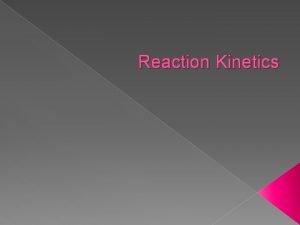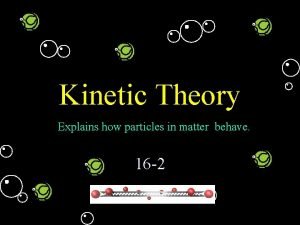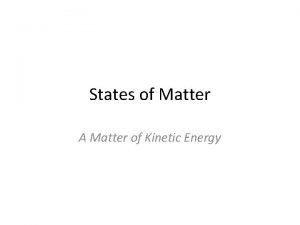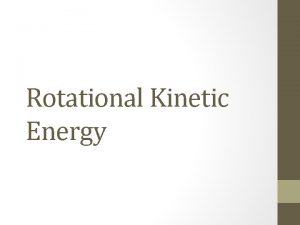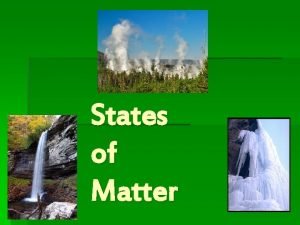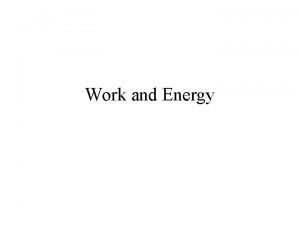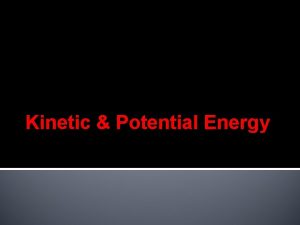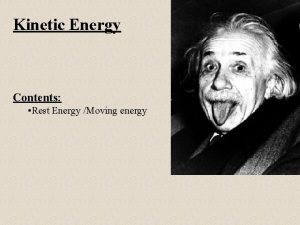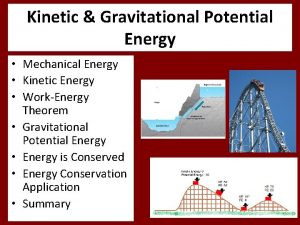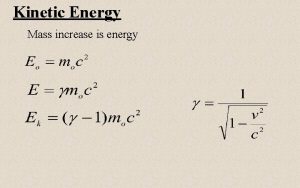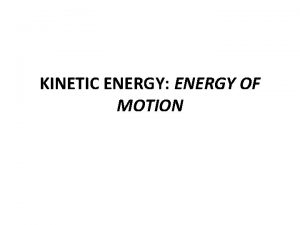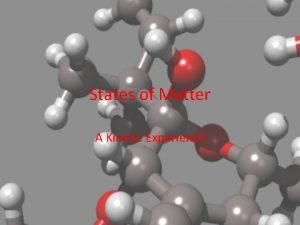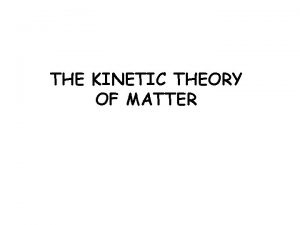Chapter 2 ENERGY MATTER Kinetic Energy KE Energy





![Calorie (cal) [older unit] The amount of energy required to raise the temperature of Calorie (cal) [older unit] The amount of energy required to raise the temperature of](https://slidetodoc.com/presentation_image_h2/6dfd6832de68c1993d5f058a63b510b5/image-6.jpg)




![3 States of Matter [Actually 4 States] Solid-definite shape & volume, maintains shape without 3 States of Matter [Actually 4 States] Solid-definite shape & volume, maintains shape without](https://slidetodoc.com/presentation_image_h2/6dfd6832de68c1993d5f058a63b510b5/image-11.jpg)









- Slides: 20

Chapter 2 ENERGY & MATTER

Kinetic Energy (KE) Energy due to motion KE = ½ mv 2 Unit KE = kinetic energy J = Joule m = mass kg v = velocity m/sec

WARM-UP PROBLEM Determine the kinetic energy for a 250 g ball traveling at 2. 5 km/min. (Remember to convert g to kg and km/min to m/s. )

Potential Energy (PE) �Stored energy �Gravitational Potential Energy –energy due to position �PE = mgh Units �PE = potential energy �m = mass J= Joule kg �g = force of gravity Earth = 9. 8 m/sec 2 • �h = height (CONSTANT) meter

See sample problem #4 What is the minimum height the ball would need to be dropped from to achieve this velocity before impact with the ground?
![Calorie cal older unit The amount of energy required to raise the temperature of Calorie (cal) [older unit] The amount of energy required to raise the temperature of](https://slidetodoc.com/presentation_image_h2/6dfd6832de68c1993d5f058a63b510b5/image-6.jpg)
Calorie (cal) [older unit] The amount of energy required to raise the temperature of 1 gram of water by 1 Celsius degree. Example #1: How much energy is required to raise 20 g of water from 50 C to 60 C? Convert this to Joules. {Remember 1 cal = 4. 184 J}

Law of Conservation of Energy can neither be created nor destroyed in any chemical or physical process. It can be converted from one form to another.

Heat Sum total of all the KE of the particles in a sample. This can only be measured using indirect means when a change of heat occurs.

Temperature Measure of the average KE of the particles in a sample. Can be measured directly.

Properties of Matter Extensive Properties-properties that are dependent on the quantity of matter. (mass, volume, shape) Intensive Properties-Not dependent on the size of the sample, characteristic properties of that substance. (melting point, boiling point, density)
![3 States of Matter Actually 4 States Soliddefinite shape volume maintains shape without 3 States of Matter [Actually 4 States] Solid-definite shape & volume, maintains shape without](https://slidetodoc.com/presentation_image_h2/6dfd6832de68c1993d5f058a63b510b5/image-11.jpg)
3 States of Matter [Actually 4 States] Solid-definite shape & volume, maintains shape without a container. Liquid-definite volume but indefinite shape, takes the shape of its container but does not fill. Gas-indefinite shape & volume, fills any container placed in. Plasma-highly ionized form of gas that exists at high temps. (surface of the sun)

Physical Characteristics Physical Properties-These are observed or tested without changing the substance. Physical change -These include changes of state such as melting, boiling, dissolving, grinding, filtering, etc.

Chemical Characteristics Chemical Properties-How a substance reacts with other substances. This is only observed in a chemical reaction. Chemical Change-When a substance is converted into a new substance. All properties and characteristics will change! Format: Reactants (start) Products (yields) (ending)

Indicators of Chemical Change 1. Evolution of heat and/or light. 2. Production of a gas (not from boiling) 3. Production of a precipitate (ppt. ) (solid but not from freezing) 4. Color change (be careful with this one, indicators cause color change but that is not chemical!)

WARM UP A runner burns about 10 kcal per minute. If the runner completes a race in one hour and fourteen minutes, how many k. J did he burn? How many J did he burn?

Mixtures Mixture-Physical combination of 2 or more substances. 2 Classifications: Heterogeneous-different composition present [examples: sand, granite, milk of magnesia] Homogeneous-same composition present throughout [examples: salt water, Gatorade, coffee]

Pure Substances Elements & Compounds These always have the same properties The same composition They can not be separated without changing properties.

Element A substance that can not be broken down into another substance by chemical means. The smallest part is an atom There approximately 90 naturally occurring elements.

Compound A substance that can be broken down into another substance by chemical means. The smallest part is a molecule or ion.

 Energy naturally flows from warmer matter to cooler matter.
Energy naturally flows from warmer matter to cooler matter. Chapter 2 section 1 classifying matter answers
Chapter 2 section 1 classifying matter answers The kinetic theory of matter states that
The kinetic theory of matter states that Kinetic theory of matter definition
Kinetic theory of matter definition Define kinetic theory of matter
Define kinetic theory of matter Buoyancyability
Buoyancyability Condensation particle theory
Condensation particle theory What is a kinetic theory of matter
What is a kinetic theory of matter Elastic energy to kinetic energy
Elastic energy to kinetic energy Formula of potential and kinetic energy
Formula of potential and kinetic energy Gravitational potential energy vs kinetic energy
Gravitational potential energy vs kinetic energy Kinetic energy to thermal energy
Kinetic energy to thermal energy Kinetic energy vs potential energy
Kinetic energy vs potential energy Definition of kinetic energy
Definition of kinetic energy Spring potential and kinetic energy
Spring potential and kinetic energy Formula of potential energy
Formula of potential energy The change in mechanical energy
The change in mechanical energy Classification of matter section 1 composition of matter
Classification of matter section 1 composition of matter White matter nervous system
White matter nervous system Classification of matter section 1 composition of matter
Classification of matter section 1 composition of matter Gyrus and sulcus function
Gyrus and sulcus function


